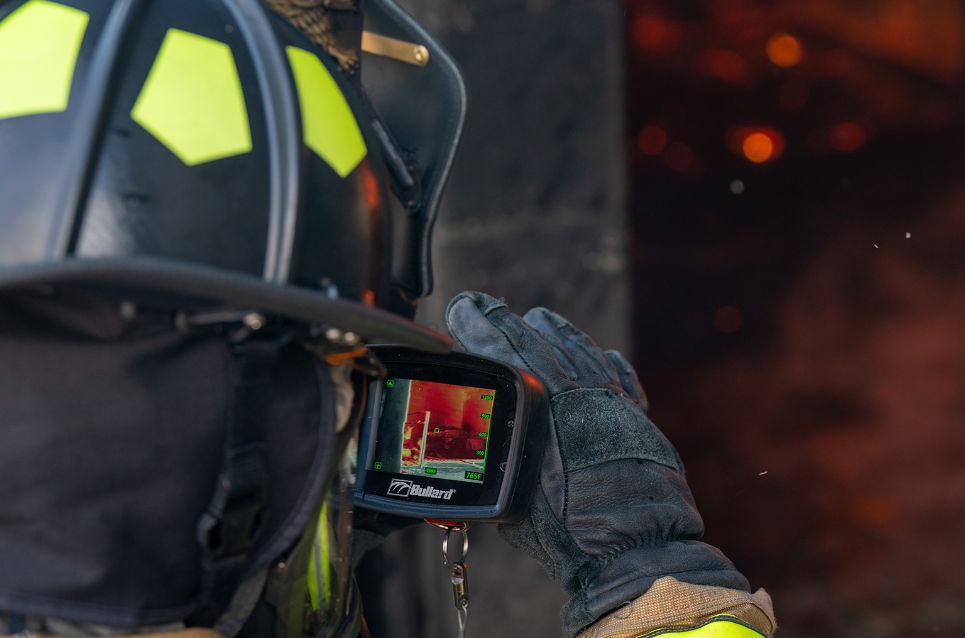When selecting a thermal imager for fire service use, battery type is a critical factor that directly affects performance, reliability, and usability. The choice between internal and external batteries can significantly impact how well a device meets your department’s operational needs. This guide examines the advantages and disadvantages of both options to help experienced firefighters and buying committees make informed decisions.
Internal Lithium-Ion Batteries: Advantages and Disadvantages
Internal batteries are built into the thermal imager, offering a seamless design and certain technical advantages. However, these come with limitations that may impact field adaptability.
Advantages
- Enhanced Durability
Internal batteries are securely housed within the device, making them less susceptible to damage from impacts, vibration, or exposure to extreme heat and cold.
- Streamlined Design
Devices with integrated batteries are often more compact, ergonomic, and lightweight, making them easier to handle during long firefighting operations.
- Improved Safety
Internal batteries typically include advanced safety features, such as protection against overcharging, overheating, or short circuits.
- Stable and Reliable Performance
Integrated power systems help ensure consistent energy output, minimizing performance fluctuations and providing accurate thermal readings.
- Reduced Maintenance
With fewer external components, there is less need for cleaning and maintenance, especially after exposure to debris-filled environments.
- Superior Environmental Protection
A sealed design enhances water and dust resistance, crucial for operating in harsh fireground conditions.
- Fast and Flexible Charging
Many devices with internal batteries support advanced charging options, such as wireless charging or USB compatibility, reducing downtime between uses.
- Extended Lifespan
Internal batteries often have longer lifespans, reducing the frequency of replacements and lowering overall costs over time.
- Eco-Friendly Design
These batteries generate less electronic waste due to their longevity and recyclability.
Disadvantages
- Charging Downtime
Devices with non-removable batteries cannot be used during charging, limiting availability during prolonged operations.
- Replacement Challenges
When internal batteries degrade or fail, replacement often requires professional servicing, leading to higher costs and longer downtimes.
- Higher Upfront Cost
Devices with integrated batteries tend to have a higher purchase price due to advanced features and sealed construction.
- Reduced Field Adaptability
If the battery depletes during a call, the device becomes unusable until recharged, which could hinder operations.

External Batteries: Advantages and Disadvantages
External batteries offer flexibility and quick field replacements but may compromise durability and require additional maintenance.
Advantages
- Flexibility and Continuous Operation
External batteries can be swapped out quickly in the field, helping to ensure uninterrupted use during extended incidents.
- Lower Initial Cost
Devices with removable batteries are generally less expensive upfront, which can be advantageous for budget-conscious departments.
- Ease of Replacement
Replacing external batteries is simple and doesn’t require professional servicing, reducing downtime.
Disadvantages
- Reduced Durability
The presence of a battery compartment introduces potential entry points for water, dust, and debris, which could compromise the device’s reliability.
- Higher Maintenance Requirements
External batteries and compartments require regular cleaning to maintain functionality. Spare batteries also need consistent charging and monitoring to help ensure readiness.
- Increased Weight
Carrying spare batteries adds to the firefighter’s load, increasing physical fatigue during operations.
- Inconsistent Performance
Over time, removable batteries may degrade, leading to fluctuations in power output and device performance.
- Risk of Loss or Damage
Spare batteries are at risk of being misplaced or damaged in high-pressure situations, especially during complex incidents.
- Environmental Impact
The need for frequent battery replacements generates more electronic waste, which may be a concern for environmentally conscious departments.
- Additional Operational Steps
Keeping batteries charged, stored properly, and ready for use adds complexity to logistics, which can be challenging during emergencies.

Key Considerations for Decision-Making
When deciding between internal and external batteries, it’s essential to evaluate your department’s specific needs, call volume, and operational preferences.
- Internal Batteries
Choose devices with internal batteries if your priorities include durability, streamlined handling, and minimal maintenance. These are ideal for departments with shorter call durations or predictable use patterns.
- External Batteries
Opt for external batteries if your team needs flexibility and the ability to quickly swap power sources in the field. This option works well for departments managing extended incidents or operations requiring continuous device availability.

Case Study: Internal vs. External Batteries in Real-World Use
A suburban fire department conducting frequent house fire responses opted for thermal imagers with internal batteries due to their compact design and longer operating hours. However, a metropolitan department managing extended high-rise fires chose devices with external batteries to help ensure continuous operation by swapping out spares. Both departments prioritized TCO evaluations, leading them to solutions tailored to their unique challenges.

Conclusion
Both internal lithium-ion batteries and external batteries have distinct strengths and limitations. The best choice depends on your department’s operational demands, budget, and preferences for durability or adaptability.
- If durability, ease of use, and ergonomic handling are critical, internal batteries offer a streamlined and reliable solution.
- If flexibility, continuous operation, and field adaptability are paramount, external batteries provide the versatility you need.
By carefully assessing your department’s needs and evaluating the trade-offs, you can select the thermal imager that enhances performance and supports your mission effectively.
For additional guidance or to explore options tailored to your department, connect with our experts here.



